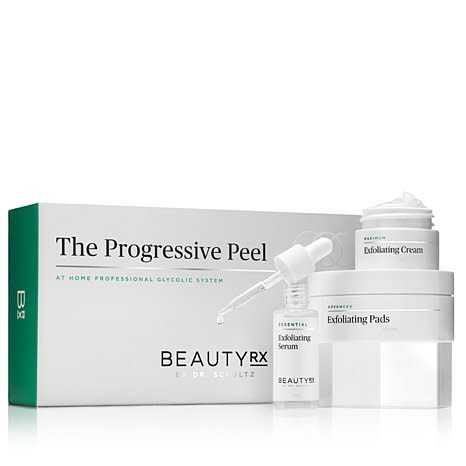Do Your Next Chemical Peel at Home

The chemical peel has moved out of the office and it’s a lot less scary than you think. (Photo: Trunk Archive)
I know I’m not alone in my fear of a chemical peel. That one episode of Sex and the City has scarred me for life. You know the one: Samantha gets ready for Carrie’s book release party by having a chemical peel and the results (super red, peeling, painful to look at skin) make it so she has to wear a veiled, beekeeper-style hat to the event. Anytime anyone has said the word “peel” over the last few years, I’ve run in the other direction. But with more and more at-home versions of the chemical peels popping up, I figured, it’s time to face my fears — or at least find out of there is anything to actually be afraid of.
I went straight to Dr. Neal Schultz, MD, a New York City based dermatologist who has performed over 55,000 glycolic peels and is the creator of BeautyRx, a product range that includes The Progressive Peel ($70), an at-home glycolic peel system. To say he knows what he’s talking about is an understatement. Schultz has been using glycolic acid in his office for years and is well versed in the history of the skin exfoliating aid. He believes glycolic acid is the “gold standard” when it comes to at-home peels and giving your skin the exfoliation it needs.
“We’re exfoliating to make the skin smooth and without dead cells that keep your other ingredients from working,” says Schultz. “When it’s smooth, it absorbs better, your skin products work better, your makeup goes on smoother, you have to use less to get an airbrush finish.” That doesn’t sound like a bad thing at all, right?

The Progressive Peel by Dr. Schultz allows you to gradually build the strength of your at-home peel treatment. (Photo: BeautyRX)
A typical in-office chemical peel uses up to 40% glycolic acid to exfoliate the skin, remove dead skin cells, and leave behind brighter and firmer skin along with a decrease in oil production and breakouts. The at-home treatment strength is typically between 5% and 12%, making it gentle enough to use on a weekly or even daily basis. “It’s the most important thing you can do on a daily basis,” says Schutlz, who says that an at-home peel as effective for his patients in their 20s as it is for those in their 40s. “You should be exfoliating every night with something of a nature that you can tolerate.” Schultz’s Progressive Peel is perfect for this, as it allows you to control the amount of glycolic acid you are applying, and still effectively removes dead skin cells daily, ensuring that your entire skincare routine is more successful since products are able to properly penetrate your skin’s surface.
You’re probably thinking, but why can’t I just exfoliate with a scrub everyday? Schultz points out that physical exfoliation will never work as well as a chemical exfoliation because the results are dependent on three variables that can’t be completely controlled: how hard you’ve scrubbed, how long did you do it, and the type of physical exfoliant you’re using (sugar, a brush, crushed nutshells, etc). While these types of physical exfoliation are good for you, they aren’t as good as using glycolic acid.
Dr. Sajel Shah, MD, of Smarter Skin Dermatology in New York City, agrees that an at-home chemical peel is a great way to exfoliate the skin but it’s important to purchase the right kind of treatment. “If you search for at-home peel on the internet, you’re going to have all of these people selling medical strength peels online and that is a problem,” says Shah. “I have patients who come in having used these and have gotten horrible chemical burns.” If you’re shopping for an at-home peel, do it at a certified retailer (like a Sephora or SpaceNK) where you know you’re going to be getting something safe and something that is packaged in a way that makes it easy to do at home.

The two step peel by Dr. Dennis Gross is packaged in easy to use packets. (Photo: Dr. Dennis Gross)
Shah is a big fan of the “packet peel” made famous by Dr. Dennis Gross (try the Alpha Beta Universal Daily Peel, $88) because it’s hard to overdo it and it’s really just two (or sometimes one) easy steps. M-61 Powerful Skincare also makes a one-step, one-minute Power Glow Peel ($28) that uses glycolic acid and salicylic acid (which is great if you have acne prone skin) to exfoliate. You can even pick up a peel at the drugstore thanks to Skin + Pharmacy Advanced Anti-Aging Therapy Glycolic Peel Pads ($20) available exclusively at CVS.
As with any new treatment, it’s always great to do a patch test to see how your skin reacts. If you’re going to try an at-home peel, test a small spot in front of your ear first. If you don’t have a bad reaction, go for it. Those with a skin infection, active eczema, or those with hyperpigmentation should be cautious about doing any kind of peel. “Just as you wouldn’t use a hair dye without a test, you shouldn’t do an at-home peel without a test either,” advises Schultz.
Post-treatment, be sure to avoid doing any extra exfoliation, this includes other chemical exfoliants (like using a retinoid), physical exfoliation, microdermabrasion and even waxing. Schultz also advises against using benzoyl peroxide products for at least two days following a peel. “When you’re using optimal chemical exfoliation, there is no reason to combine additional exfoliation. If you push too hard, you’re going to get irritated,” says Schultz.
The best part about these at-home treatments is that there isn’t any downtime. Schultz says the idea of downtime associated with peels is the biggest misconception, adding that even with his in-office treatments have you leaving the office with better looking skin — no need to hide under a veil.
Related:
Why Pressed Serums are the Next ‘It’ Product

 Yahoo News
Yahoo News 
